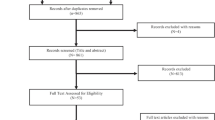Abstract
This paper addresses the strange bedfellowship between psychoanalysis and cinema since the century's turn. Its specific focus is the idiosyncratic psychoanalysis/psychotherapy “practised” in mainstream cinema and television. “Cinetherapists” have consistently fallen into one of three categories: Dr. Dippy, a focus of derision, weirder than his patients; Dr. Evil, Hollywood's psychiatric version of the mad, bad scientist; and the unfailingly benevolent, self-sacrificing Dr. Wonderful. The prevalence of these stereotypes has waxed and waned according to shifting cultural circumstances. The study concludes with reflections on the possible impact, deleterious or otherwise, of distorted filmic images of the “impossible profession.”
Similar content being viewed by others
References
Chodorkoff, B., and Baxter, S. (1974). Secrets of a Soul: An early psychoanalytic film venture.” American Imago, 31:319–34.
Farber S., and Green, M. (1993). Hollywood on the Couch: A Candid Look at the Overheated Love Affair between Psychiatrists and Moviemakers. New York: William Morrow.
Gabbard, G.O., and Gabbard, K. (1999). Psychiatry and the Cinema, Second Edition. Washington, DC: American Psychiatric Press, Inc.
Greenberg, H.R. (1992). Psychotherapy at the simplex: Le plus ca shrink. Journal of Popular Film and Television, 20: 9–15.
Greenberg, H.R. (1993). Screen Memories: Hollywood Cinema on the Psychoanalytic Couch. New York: Columbia University Press.
Greenberg, H. (1994). Freud at the Bijou, Academy Forum, 38: 8.
Greenberg, H.R. (1999). Take two: Jewish doctors in film, Hadassah Magazine, 80:46–51.
Jones, E. (1957). The Biography of Sigmund Freud, Vol. 3. London: Hogarth Press.
Schneider, I. (1987). Images of the mind: Psychiatry in the commercial film, American Journal of Psychiatry, 144: 996–1002.
Schneider, I. (1985). The psychiatrist in the movies: The first fifty years. In J. Reppen and M. Charney (Eds.), Psychoanalytic Study of Literature, pp. 53–67. Hillsdale, NJ: Analytic Press.
Author information
Authors and Affiliations
Rights and permissions
About this article
Cite this article
Greenberg, H.R. A Field Guide to Cinetherapy: On Celluloid Psychoanalysis and Its Practitioners. Am J Psychoanal 60, 329–339 (2000). https://doi.org/10.1023/A:1002090730270
Issue Date:
DOI: https://doi.org/10.1023/A:1002090730270




